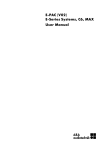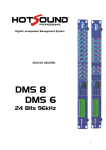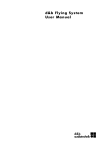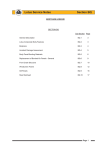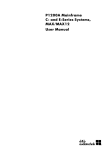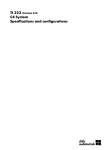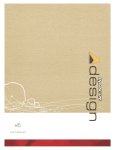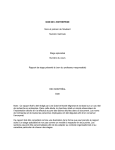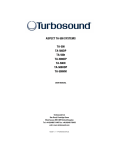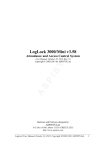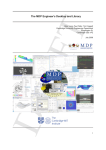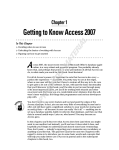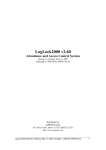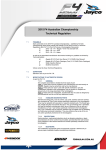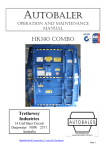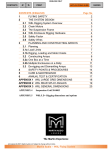Download - Martin Audio
Transcript
BACK TO INDEX Wavefront 8 – Flying System (Transformer) User Manual The Martin Experience All material © 2007. Martin Audio Ltd. Subject to change without notice. BACK TO INDEX Martin Audio Wavefront 8 – Flying System (Transformer) User Manual Publishing information Martin Audio Flying System Ltd. User Manual Version 2.01, June 2000 Copyright Martin Audio Ltd 1997 / 2000; all rights reserved This publication may not be reproduced, transmitted or held in a retrieval system in part or in whole in any form or using any electronic, mechanical, photocopying or recording process without the prior permission in writing of the publisher. Whilst every care has been taken to ensure the accuracy of the information presented in this publication, Martin Audio Ltd. will not be held responsible for any errors or omissions or for the consequences of any errors or omissions. Technical specifications, weights and dimensions should always be confirmed with Martin Audio Ltd. prior to inclusion in any additional documentation. Section 1 Introduction "WHY"???????. Flying frames of all shapes and sizes have been made over the years, many performing a relatively competent function. unfortunately most of them have one feature in common.- “They only really work properly when used to maximum capacity.” the size of a flying bar is controlled by two things, the downward curvature or "Kelping angles" and the horizontal dispersion of the cabinets. so the size of the bar is established from the bottom corners of the bottom row of cabs touching and then growing vertically. All material © 2007. Martin Audio Ltd. Subject to change without notice. BACK TO INDEX Figure 1 Shows the Bottom corners touching. And the spacing formed by kelping and horizontal dispersion angles. This development changes if a manufacturer has cabinets with different dispersion angles, wide angle/long throw/Combi etc. so it is difficult to format a bar that will accommodate all of these requirements. If a lesser number of cabs are flown, large gaps appear between the bottom row of cabs and looks untidy as well as being much wider than is necessary. This is where the transformer series comes into its own, the ability to alter horizontal dispersion of individual rows of cabs to any angle without altering any other (this can be done one handed even under full load) and the ability to adjust the width between column is to insure a neat compact array regardless of dispersion, kelp, weight or number of cabs, is we believe unique to the "Transformer" series bar. The second problem that is seldom addressed by other flying system manufacturers, is that of the stresses and strains induced by the use of multi- chain hoist lifting assemblies. It is virtually impossible to control the different climb rates between motors as the loads per section and mechanical performance between individual chain-hoists, let alone of different manufacture can vary considerably. This means that the system is not going to be lifted as one, this will induce cross-loading from one part of the system to another and this can greatly exceed the S.W.L. figures and indeed the design loads. The "Transformer Series" system can compensate for up to 15 degrees of in-balance or climb rate without adding any increase of load or stress, This is achieved by the use of ball and rose type pivots which also allow the greater positional flexibility, Indeed how many other systems can change from a straight line of four cabinets, to a 360 cluster, by one man whilst fully loaded and off the ground?. All material © 2007. Martin Audio Ltd. Subject to change without notice. BACK TO INDEX Creating a safe, affordable, easy to use, loudspeaker flying system confronts designers with a whole series of conflicting demands and engineering problems. The ideal flying system would probably incorporate the following key features: (1) (2) (3) (4) (5) (6) (7) (8) (9) (10) Ultra high load safety factor Ultra high strength Ultra high load carrying ability. Easy to transport Next to no truck space Simple and quick to set-up, load and fly Completely adjustable in every plane Easy to adjust - even when loaded All adjustments, angles etc. lock rigidly once set Can be used with any type or mix of cabinets. Although essentially an unattainable goal, the above design criteria for an ideal flying system provide a benchmark by which to judge the effectiveness of a given design and help indicate areas for improvement. The flying system described in this manual was originally designed, developed and is manufactured by UK specialist MAN Flying Systems Ltd. to allow the swift, safe and accurate deployment of flown arrays of loudspeakers. Flying Safety The prime concern in the design and use of loudspeaker flying systems is safety - the safety of the public, performers and all of those who work with flying systems. Safety issues connected with the use of flying systems are shrouded in confusion. Fearful of litigation, manufacturers often fail to provide basic assembly and safety information on the use of their systems. Users are frequently left to fend for themselves to ensure compliance with legislation, codes of practice, and insurance requirements covering the use of flying systems. The simple question - What is an acceptable load safety factor for flying components above their certified SWL (Safe Working Load)? - illustrates the confusion. The answer depends upon geography and the differing views of safety authorities. In some Countries a load safety ratio of 2:1 is considered acceptable, whilst in Germany, a load safety ratio of 12:1 may be demanded. Needless-to-say, the Martin Audio flying system meets the more stringent German VBG70 standard. All components used in the flying system are conservatively load rated and the materials, design techniques and processes used in the manufacture of the components are chosen to maximise the safety and structural integrity of the system design. To verify the safety of each flying system, after manufacture, the flying system components are carefully inspected, assembled and then despatched to an independent test station. On completion of the external tests, including a load test at twice the certified SWL, the components then return to the MAN factory where all safety critical components and assemblies are stamped or engraved and the manufacturers label attached. All material © 2007. Martin Audio Ltd. Subject to change without notice. BACK TO INDEX Each Martin Audio flying system is manufactured and sold as a complete two or three wide assembly and each major component or sub-assembly is traceable as part of a specific, complete flying system. Each system should always be treated as a complete system and for safety's sake, components or sub-assemblies should never be swapped between different systems. Despite all the care taken in the design and manufacture of the flying system, Martin Audio Ltd. cannot guarantee complete safety whenever a flying system is used. Safety in use is crucially dependent upon the safe working practices of flying system users. This manual is not the definitive guide to safe working practice in the use of flying systems but is advisory in nature and intended to promote safety by providing clear information on the capabilities, adjustment and safe use of the flying system. The advice and information contained in the manual does not absolve users from complying with any legal safety requirements and codes of practice in force at a time and place where a Martin Audio flying system is deployed. Different operating and safety requirements between and within countries make it impossible to give universally definitive advice on safety – the requirements which can apply to flying system users. The best possible advice is that the rigging of loudspeaker flying systems in public or working areas should only ever be undertaken by specialist contractors or by members of a site or touring crew with established, proven expertise as riggers. Important! Everyone involved in the on-site assembly and deployment of a loudspeaker flying system has a duty to ensure the safe construction, adjustment and deployment of that flying system. It is therefore crucial that every Martin Audio flying system user has the opportunity to read and fully understand the advice and information presented in this manual. Every Martin Audio flying system user also needs to be properly trained in the safe use of the system before ever constructing and deploying the system in a working situation. Section 2. The System Design. All material © 2007. Martin Audio Ltd. Subject to change without notice. BACK TO INDEX Introduction The Martin Audio flying system allows arrays of loudspeaker cabinets to be vertically suspended or 'flown' from suitably secure and appropriately load rated rigging points in the roof structure of a theatre, hall or indoor arena. The Martin Audio flying system complies with the 12:1 load safety factor specified by the VBG70 standard and is solely and exclusively intended for use with the Wavefront 8 Family of loudspeaker enclosures. 2.1 Components The basic components of the flying system are MAN “D ring” type flying studs plates, steel suspension chains and ratchet straps. A flown array is composed of sideby-side columns of suspended loudspeaker cabinets. Each cabinet in an array is fitted with a pair of MAN keyhole cabinet fittings, so that by using pairs of steel suspension chains,(fitted with MAN ‘D’ Rings) columns of cabinets may then be suspended from the flying system sub bars. The vertical angle of each column is adjusted and set by tensioning a webbing ratchet strap threaded through a central slot in the sub bar and special fittings (kelping bars) on the backs of the cabinets. The basic building block of the Martin Audio flying system is the two wide flying bar. Each bar is supplied as a complete assembly with safety wires fitted and two permanently attached sub bars. The flying bar controls the horizontal angle of the suspended loudspeaker columns and is fitted with balance adjusters to cope with different loudspeaker loads. To create wider Sub bar arrays, two wide bars can be linked together at defined angles using adjustable spreader bars. Picture 2. Shows a two wide assembly (safety wires not fitted}. Sub bars are an integral part of the two wide flying bars. The sub bars are permanently attached to detented tracks beneath each flying bar. Each sub bar allows a single column of cabinets to be suspended. The actual sub bar (pictured below) is a square section steel tube with a steel strip welded beneath. Holes each end of the sub bar accept safety hook suspension chains and, in the middle, there is a slot for a webbing ratchet strap and a hole for use as a cable anchoring point. Sub-bars. Picture 3. All material © 2007. Martin Audio Ltd. Subject to change without notice. BACK TO INDEX A sub-bar with kelping strap slot and cable support hole. Separate sub bars with adapter hooks and safety wires can be supplied for one wide applications. Picture 4. Connection Components All material © 2007. Martin Audio Ltd. Subject to change without notice. BACK TO INDEX To suspend a column of cabinets, Adjustable length hook chains fitted with MAN flying studs plates are fitted to the sides of each cabinet. Using a pair of shortened chains the top cabinet in the column is first hung from the sub bar outer suspension points. Additional cabinets are then hung, beneath the top cabinet using a longer length hook chains between each cabinet's . Picture 5. Shows the keyhole fitting in the cabinet and the release button retracted prior to fitting (Retracting the button is not strictly necessary on fitting the stud plate but is essential for removal). Picture 6. Shows the flying ‘D’ ring in position. Chain identification. The chains are left and right handed and are identified by coloured rings on the top connector link, red for left and green for right (international port and starboard). These are All material © 2007. Martin Audio Ltd. Subject to change without notice. BACK TO INDEX fitted with the red left chains to stage left and the green right chains to stage right when viewed from the rear. Coloured I.D. Ring Picture 9. Showing the hook point facing forward and the coloured ring designating left. Chain shortening clutches. All material © 2007. Martin Audio Ltd. Subject to change without notice. BACK TO INDEX To stop damage to the cabinet face, always fit the clutch on the outside of the chain. Picture 10. Showing the correct use of the shortening clutch. As the column is being assembled, 5t webbing ratchet strap is threaded through the sub bar centre slot and through the kelping bars fitted on the back of each cabinet. On tensioning the ratchet strap, the vertical angle between the cabinets will assume a certain fixed value dependent on the type of cabinet, and the length of chain used. As more tension is applied to the ratchet strap, the angle between the cabinets in the column remain fixed and the whole column assumes a curved shape as it begins to tilt downwards. The ratchet strap should never be so highly tensioned that the short chains used between the sub bar and the top cabinet become slack and cease to be load bearing. Cabinets used as downfills can be fitted with MAN D-rings and suspended beneath the bottom cabinet in a column. A short, thin ratchet strap threaded through the bottom kelping bar of the column is used to pull back and angle the downfill. Short safety chains are supplied pre-fitted between the two wide bars and their sub bars - these must not be removed. The sub bar described above is only ever supplied as part of a complete system and should never be used on its own to suspend cabinets. Two wide bar Fabricated from steel box section, the two wide bar has a detented track with four captively mounted sliding blocks on its underside. Pressing a spring loaded pushbar on All material © 2007. Martin Audio Ltd. Subject to change without notice. BACK TO INDEX each sliding block frees the block to travel along the track - releasing the push-bar locks the block into position on the track. Picture 11. Coarse setting of the horizontal angle between two columns of cabinets is accomplished by altering the distance between each pair of sub bar sliding blocks. Picture 12. Fine adjustment of column angles is achieved by rotating the screw jack barrel. Two side-by-side columns of cabinets suspended from sub bars are in turn suspended beneath a two wide bar. The outer pair of sliding blocks employ a ball-jointed pin to provide the load bearing connection between the two wide bar and each sub bar. Each inner block connects to the top of its sub bar by a non-load bearing floating link pin and integral screw jack angle adjuster. Deeper columns of cabinets and more extreme vertical coverage angles require greater horizontal separation between each column. This is achieved by moving the outer blocks further apart towards the each end of the bar track. NOTE. The two outer load blocks can only be moved with the load weight removed. All material © 2007. Martin Audio Ltd. Subject to change without notice. BACK TO INDEX Balance Block. Pictured below is the balance block and calibrated balance adjuster of a two wide bar used as the left bar of a four wide array. The balance adjuster is used to level the bar horizontally when different weights of cabinets are suspended from each sub bar. A knurled adjuster allows the bar suspension point to be shifted along a leadscrew left or right of the physical centre of the bar. Picture 13. The balance adjustment is always in the direction of the heavier load and must be preset before any cabinets are loaded. So that both balance adjustment scales in a 4 wide system can be viewed from the same side of the array, two wide bars are manufactured in left and right versions. The balance block connector arms of a pair of left and right bars always point towards each other. A DOS based program has been written by M.A.N. called "TRANCALC" for two wide systems and "TRI-CALC" for the three wide variant. The suspension point for the two wide bar is a U10 Unilock shackle fitted to the Top swivel assembly. The ball joint end of the top swivel pin is held captive in a socket in the bar balance block. The middle section of the load pin assembly incorporates a double hinge for attaching a spreader bar to either side. The free movement of the ball of the load pin in the balance block socket prevents the pin from shearing if the bar is slightly off-balance. A badly balanced bar more than 15° from level, will force the neck of the load pin against the bevelled edge of the balance block socket. Thus subjecting the pin to a dangerous shearing force, never allow a two wide bar or any flying bar to hang in a badly balanced state. Spreader Bar. The spreader bar is used to connect two wide bars at a set distance and horizontal angle apart. The exact distance apart depends on the depth and geometry of the array and is set by adjusting the length of the spreader bar using the captive All material © 2007. Martin Audio Ltd. Subject to change without notice. BACK TO INDEX Tommy-bar at its centre. Picture 14. Picture 15. To aid adjustment each end of the spreader bar has a scale calibrated in 5cm increments from 140cm to 185cm - the distance referred to is that between the rigging points of each bar. All material © 2007. Martin Audio Ltd. Subject to change without notice. BACK TO INDEX At each end of the spreader bar a machined slot with a sliding latch and captive pin is used to connect and secure the bar to one of the hinges on the Top swivel assembly of each flying bar. Picture 16. Picture 17. The threaded section each end of the spreader bar has an adjustable screw collar which connects via a floating link connector to the balance block on top of the flying bar below. It's the position of the screw collars on the spreader bar which defines the horizontal angle of the two wide bars relative to the spreader bar. This mechanism for defining All material © 2007. Martin Audio Ltd. Subject to change without notice. BACK TO INDEX the horizontal angle has the advantage that it doesn't affect the balance of the flying bars. (picture 17.) As an aid to adjustment, scales calibrated in 5° increments from 0° to 60° are set into each side of the threaded sections of the spreader bar. Due to the compressed adjustment range at the lower end of the spreader bar scales, accurately setting small angles require greater care. NB. Before connecting the spreader bar link connector to the link arm of the two wide bar balance block, press the small spring loaded button (A) on the arm. NEVER - Try to force the link connector pin into the link arm without depressing the button (A). Picture 18. Picture 19. Lifting Components. Flying Studplates (D-rings), cabinet fixing, suspension chains, straps and safeties. Built into the sides of loudspeakers intended for use with the Martin Audio flying system are circular Key hole plates known as Cabinet Fittings which mate with MAN D-ring flying studs - the flying studs are a key component of the flying system design. With the cabinet upright and the narrow part of the stud plate keyhole to the top fitting the studs is simple. The knob inside the D-ring is pulled back to extend the locking stud which is then fitted into the larger aperture of the keyhole. The stud is pulled upwards and the knob ring released, the D-ring stud should engage with the fixing so that the two components are securely locked together. To remove the D-ring the above fitting procedure is carried out in reverse order. See pictures 5&6, The D-ring and cabinet fixings provide the load bearing suspension points for attaching loudspeaker cabinets to the flying system sub bars. The length of the chains used will depend on the size, shape, weight and centre of gravity of the cabinets - your All material © 2007. Martin Audio Ltd. Subject to change without notice. BACK TO INDEX loudspeaker supplier will advise on the length of chains required for use with a particular loudspeaker system. In a typical case, using Martin Audio Wavefront 8 cabinets, A handed pair of 57 link chains fitted with shortening clutches is used for both the top and subsequent rows of cabinets enabling a column of cabinets up to 4 deep to be suspended from each sub bar. Suspension chains supplied by Martin Audio are terminated a safety hook and shortening clutch at the top and a D-ring at the bottom, and should be fitted with the open end of the hooks facing forward, and the shortening clutch away from the cabinet. To assist rapid recognition of left and right chains the top hook connector is fitted with a coloured ring -red for left and green for right (International port and starboard convention) when viewed from the stage i.e. red chains are always towards “Stage Left”, green to “Stage Right”. (See picture 9. Page 9.) Care should also be taken to ensure that chains are free of twists when fitted. Ratchet Straps. A 5t webbing ratchet strap 10 m long is used to link the cabinets together and set the vertical angle of the column. The strap is first of all threaded through the centre slot of the sub bar and then through the kelping bars at the back of each cabinet before being wound into the ratchet mechanism and tensioned. The following sequence of pictures may help explain the threading procedure, Note! As an aid to assembly the pointed end of the webbing strap is offset. With the ratchet mechanism open and the stitched flap uppermost the long side of the webbing point should always be on the left. Ratchet strap threading routine. This routine should be started before the sub-bars are out of reach, usually one or two cabs high. Always start with the strap fully unwound and the long edge of the webbing point towards the left. The long edge must be kept to the left throughout the threading the operation. Pass the point through the slot in the sub-bar from the rear with the point, long side left.(picture 16). Picture 20. All material © 2007. Martin Audio Ltd. Subject to change without notice. BACK TO INDEX Picture 21. This shows how the webbing is passed down through the top kelping bar of the top cabinet, this is also passed through the bottom kelping bar ,and this is repeated on each lower cabinet. Picture 22. Picture 22 shows the straps being threaded with the system lifted just of the ground. This allows free access to all the Kelping bars without excess effort. All material © 2007. Martin Audio Ltd. Subject to change without notice. BACK TO INDEX Picture 23. The strap should be adjusted so the Ratchet mechanism is roughly level with the joint between the two lower cabinets. And with the lever closed. thread the strap point with the long side on the left. Picture 24. Pre-tensioning the ratchet strap, Lifting the bottom cabinet by pulling up the strap and at the same time pulling on the free tail end, clutching both together with one hand and start tensioning by pulling the ratchet lever. It should be noted that the ratchet spool will become over loaded if some amount of pre-tension is not applied. All material © 2007. Martin Audio Ltd. Subject to change without notice. BACK TO INDEX Picture 25. With the ratchet lever closed the Webbing tail rolled up and secured with adhesive tape. Picture 26. Shows a Complete two deep assembly with the ratchet mechanism in the final position. Releasing the ratchet strap. All material © 2007. Martin Audio Ltd. Subject to change without notice. BACK TO INDEX Extreme caution must be taken when releasing the rear tension strap!. When the rear tension strap is released the lower cabinets swing forwards, It is essential that the area in front of the system is clear of people and or equipment. To release the tension on the rear strap, fully open the ratchet lever and pull the release bar as shown Always ensure the area in front of the system is free from people or other equipment!. Picture 27. Tensioning of the rear strap forms the speakers into a neat curved column. Applying a certain degree of extra tension alters the downward tilt of the curved column. Please note that the webbing strap is only intended to set and maintain the vertical curve and downward angle of an array column and is not a load bearing element of the design - that is the proper function of the suspension chains. Users must be familiar with the care and safe use of ratchet straps and follow the instructions provided by the strap manufacturer. Safety Wires. All material © 2007. Martin Audio Ltd. Subject to change without notice. BACK TO INDEX Although the flying system is conservatively load rated, for maximum safety, an additional secondary rigging point should always be provided and used. The two wide flying bar is supplied with a steel wire rope safety bridle. The free ends of the safety bridle are attached to the safety lugs on the bar using 2t shackles. The steel O ring of the bridle should be attached to a suitable, secure overhead rigging point, structurally independent of the main hanging point for the system. It is recommended that the safety bridles remain permanently attached to the bars as a reminder that they must be used. Note! The practice of crossing one safety bridle to an adjacent load hoist is not recommended , in the event of a motor or system failure this would induce a violent rotating action that would induce shock loads in directions the system is not designed to cope with. Accessories. 600mm Chain Bucket Extension chain. This 7mm Extension chain is intended, when height allows, to raise the chain bucket or bag up clear of the main system removing the possibility of interference of the top bar balance. Flight Case. A flight case is available to transport a complete four wide system consisting of a pair of two wide bars, four sub bars and spreader bar plus safeties and speaker cable looms. The transformer flying system is not designed to be man-handled but used from a flight case directly by the chain hoists. Chain flight Case. A rugged flight case custom built to suit rigging chains and stud plate assemblies is available. Section 3. Planning and constructing arrays. Planning A site survey should be conducted before arriving on site and a rigging plan prepared. The rigging plan should include details of the number and type of cabinets to be flown, their position in the array as well as the angles needed to best cover the audience areas of the venue. The plan should also include the weight, intended height and position of the load(s) to allow the venue riggers to select the rigging points needed to suspend the flying system from the roof of the building. Note...The adjustable spreader bar used between two wide bars is designed to take the load on two individual chain hoists or alternatively by use of a 90 degree two leg lifting chain or wire bridle this also accommodates the possibility of miss-positioning of the rigging points up to 45 degrees. NOTE...never exceed the load rating of the chain hoist being used. All material © 2007. Martin Audio Ltd. Subject to change without notice. BACK TO INDEX Load limits To maintain the 12:1 load safety margin of the flying system, the above hook rigging roof structure, rigging and motor chain hoists - should all be capable of supporting loads 12 times that of a fully loaded flying system. The 12:1 load safety margin of the flying system is only fully available when both flying system and load are vertically suspended - any deviation from the vertical will reduce the load bearing capacity of the flying system. Rigging, loading and motor hoists The rigging plan allows users to determine the exact position of the rigging points needed for the array described. Accept when flying the four wide configuration (see note 3/1) The chains or steels suspended from the rigging points should hang vertically with the array attached - if they do not, then the horizontal shearing forces introduced by misalignment will reduce the load safety margin of the flying system. Because of this factor, users must ensure the correct position and spacing of the rigging points. But the most obvious result of miss-positioning will be that the hole system will not array in the intended manner. Normally, a four wide system is flown from two separate rigging points, a bridle chain can however be used to fly a system from a single rigging point. For bridled, single point suspension the load ratings of the motor hoist, above hook rigging and the rigging point will all need to be double that used for normal twin point suspension. To ensure that the rated 12:1 load safety factor of the MAN flying system is maintained always check the actual total load of the flying system, rigging and loudspeaker cabinets. Alternatively a reduced number of cabinets should be used. (see rigging calculation section and "Trancalc"/"TRI-CALC"). In calculating the total load on each rigging point remember to include the weight of the motor, cables and any additional rigging - for typical multi-point rigging setups it should be possible to keep the total load on each rigging point to under 1 Tonne allowing the use of motor hoists with a 1 Tonne rating (SWL).Always consult your MARTIN AUDIO data sheets for cabinet weights. All relevant data is included in "TRANCALC"/"TRI-CALC" software. Constructing an array Assembly and deployment of a flying system array is carried out in three stages: 1, Unpacking, pre-setting and safety checks 2, Loading, cabling and aligning the system 3, Raising and securing the system Note that all adjustments to the flying system must only be carried out by hand - no levers, hammers, mechanical implements or other aids should be used to apply additional force. Careful planning and preparation will minimise the physical effort needed to assemble and deploy the system. For instance, it helps to set out the cabinets in the correct order on the ground before constructing the array a row at a time. Rather than using muscle power, the chain hoist motors should be used to do the heavy lifting. All material © 2007. Martin Audio Ltd. Subject to change without notice. BACK TO INDEX Unpacking, pre-setting and safety checks The following description applies specifically to the deployment of a four wide flying system using a pair of two wide bars and a spreader bar. It is assumed that all above hook rigging has been completed and that the chain hoist motors are in position. The motor hoist chains should be free of twists and should hang exactly in the position defined in the rigging plan. Beneath the chain hooks there should be sufficient clear space to wheel in a flight-cased four wide flying system. Pre-setting Three pre-set adjustments described below are always carried out on a flying system before loudspeakers are loaded. These three adjustments depend upon the size and composition and of the array and the type of loudspeakers used – contact martin Audio or your supplier for detailed guidance. and or consult "TRANCALC"/"TRI-CALC" software. 1, BALANCE 2, DETENT & DETENT/SCREW-Sub-bar detent settings, screw jack settings 3, LENGTH Spreader bar length setting Bar balance setting. Before even lifting the bars from their flight case the balance of each two wide bar should be set. The BALANCE setting can in fact only be carried before the bar is loaded. The balance setting for each two wide bar depends upon the mix and position of the cabinets suspended from that bar.-- Consult Rigging calculation section."TRANCALC"/"TRI-CALC" software. Unpacking. Having carried out the balance setting, each two wide bar can then in turn be securely attached by its lifting point to a motor hoist hook and lifted out of the flight case.-Note two wide bars are handed, left and right. With the M.A.N. name plates facing forward and the red and green coloured patches to the stage the top linking arms should be towards each other.- When attaching each bar to its hook ensure the motor hoist chain bucket is positioned behind the bar with the safeties to the front. Chain buckets can lean against the main bars and can influence the way they hang. Where height permits a 600mm Extension chain can be inserted between the top U10 shackle and the chain hoist, this allows the bucket to hang clear of the system.(see flying accessories.) The balance adjustment of each two wide bar should be set before proceeding. At this stage the individual bars can be raised to about waist height, just clear of the flight case. Detent settings The sub bar sliding blocks on the detented track of each bar should now be positioned to set the width between columns and the horizontal angle of each loudspeaker column. The position of the blocks will depend on the depth of the loudspeaker column.- Consult rigging calculation section. All material © 2007. Martin Audio Ltd. Subject to change without notice. BACK TO INDEX The rigging calculation section and “Transcalc”/”Tricalc” work by measurements from the centreline, but can sometimes be translated to referring to the number of detents visible. This can make thing a lot simpler in a touring situation. The 'DETENT' value is the number of track detents visible between each outer sub bar sliding block and the ends of the bar track. each detent space is equal to 20mm from the bar centreline. The first number of the DETENT/SCREW setting gives the number of track detents which should be visible between each pair of sub bar sliding blocks. The second number gives the recommended fine adjustment set using the screw jack. Spreader bar length setting The final pre-set adjustment is the spreader bar LENGTH setting - adjusted using the captive 'Tommy' bar and calibrated scale. The bar should be attached to each of the two wide Top hinge flags noting that both ends of the scale are the same,(any difference can be corrected by turning either end until it matches the other). The spreader bar length should now be set. The fixed length link bars attached to screw collar angle adjusters at each end of the spreader bar can now be linked to each two wide bar (Note, the small release button in the side of the top arm must be depressed when fitting the ballpeg or damage will result see.pics 18/19 page 15.) and the angle required between the bars can then be set. Final adjustment of the spreader bar length can be made with the system just off the ground. (This will usually be the same as the distance between each of the load blocks on the two wide bars). Loading, cabling and aligning the system. The loudspeaker array is generally built two rows at a time. The first row of cabinets are stacked in order on the ground beneath the suspended sub bars of the flying system as detailed in the array plan. The top cabinet in each column is attached to its sub bar using a pair of chains assemblies. Important! Note that where cabinets such as the W8C are fitted with four flying points to allow the cabinet to be flown inverted, only the upper flying points should be used – do not connect the lower flying points on one W8C to the upper points on the cabinet below. Whilst building the array the ratchet straps can be threaded through the sub bars and cabinet kelping bars. The strap end is then threaded through all the kelping bars on the rear of the column starting with the top cabinets the lower rows as they are added. The length of ratchet strap used will depend on the actual size and number of cabinets used in the column - refer to your loudspeaker manufacturer or supplier for detailed guidance. The system is then raised a short distance in the air to allow the next row of cabinets to be wheeled beneath, tipped and stacked. The system is then lowered with the first All material © 2007. Martin Audio Ltd. Subject to change without notice. BACK TO INDEX row resting safely on top of the second row. Another pair of chains are then used to connect the second row of cabinets to the D-rings of the first row. This process is repeated until all the rows of cabinets are attached to the flying system. Make sure that all the red chains are on the left and green to the right(viewed from behind the array ),the open ends of all the safety hooks face forward, clips closed with the chains free of twists. The ratchet strap threading procedure is covered in more detail on pages 16-20. To finally thread the end of the strap into the ratchet mechanism the bottom cabinet of the column may need to be pulled back. Because of the limited capacity of the ratchet mechanism, thread through as much of the strap as possible before final tensioning. To allow later adjustment, the ratchet mechanism is best positioned about 1 Metre from the bottom of the column. The ratchet mechanism is then cranked to tension the ratchet strap and set the curve of each array column. Applying additional tension sets the downward vertical angle of each column. With the completed array raised a short distance in the air, any errors in the pre-setting of the horizontal balance of the flying bars will become glaringly obvious. Note that a gross horizontal balance error can cause a sub bar column to flip backwards from a +15øsetting to a -15ø setting. Any necessary adjustments to the horizontal balance of the bars is always carried out with the array lowered and resting securely on the ground. For four wide arrays as well as checking balance and angles, at this stage any minor adjustments needed to the length of the spreader bar due to deviations from the planned positions of the rigging points can be carried out. The flying bar safeties should now be attached to their rigging point(s) and arranged so that they do not affect the balance of the system, attach the speaker multicore cables and the cable for the chain hoist motor. At this stage a check should also be made to ensure that the chain hoist motors operate correctly, running at the same speed so that system rises steadily, on the level and that the chains are not twisted and feed unhindered into and out of the chain bucket. Make sure the chain bucket is positioned so that it doesn't touch the sub bars. Now is the time to carry out a visual check of the appearance and alignment of the array. An important point to note is that even with properly balanced flying bars, adjacent array columns are unlikely to be perfectly aligned. In particular, assuming that the top cabinets of each column have the same downward angle, height differences of some cm can be expected between the columns. The different centres of gravity of the mix of cabinets in each column produce this slight misalignment of the columns - these misalignments, whilst visually annoying, have little impact on the acoustic performance of the array. Do not be tempted to try and correct these visual imperfections by perhaps strapping adjacent columns together - this can't be done without adversely affecting the bar balance. Raising and securing the system When all mechanical adjustments, system checks and safety checks are complete the array can then be raised to its operating position and secured. All material © 2007. Martin Audio Ltd. Subject to change without notice. BACK TO INDEX The safeties provided on each flying bar must then be secured to their own rigging points. The rigging points for the safeties must be suitably load rated and structurally independent of the main rigging points used to suspend the flying system. Instruct the rigger attaching the safeties to be careful not to disturb the balance or positioning of the array. During the lifting operation watch out that the loudspeaker multicores do not become entangled in the array - the cables can be taped together as the system rises. Take care that both hoist motors operate smoothly and lift at the same rate so that the system remains stable and level as it rises. De-rigging and dismantling the array. De-rigging and dismantling the array is essentially a reversal of the procedure followed to construct and fly the system and the same precautions and safety measures apply. The safeties to the roof structure are first of all released. No one should be present in the area beneath the array whilst it is lowered in a even, smooth and controlled fashion. The motors should be stopped when the array reaches a position about half a meter or so from the ground, the ratchet straps can be then be carefully released allowing the array columns to hang vertically. The straps are then unthreaded from the kelping bars of the bottom two rows of cabinets and the cable loom of multicore tails and speaker link cables unplugged and removed. The array can then be carefully lowered so that the cabinets rest steady on the ground. The studs and chains of the two bottom rows can then be removed and the remainder of the array raised carefully a short distance into the air, the bottom two rows are then moved out of the way and the same process repeated for the remaining rows of the array, two at a time. Section 4. Safety Points & Procedures. (1). To ensure safety, the rigging of loudspeaker flying systems in public or working areas should only be undertaken by specialists, contractors ,venue or touring crew personnel with established, proven expertise as riggers and who have read this manual. Personnel assembling a system on site have a duty to ensure the safe construction, adjustment and deployment of the system. Before use all the system components must be subjected to careful and rigorous inspection and any component or assembly which has been misused or damaged must be immediately rejected and replaced. If there is any doubt what-so-ever about the safety and integrity of the system then it must not be deployed. (2). The safety of the system is affected by its operating environment. If for instance, a flying system is deployed out-of-doors during heavy rain, high winds or storms then inevitably, safety will be compromised. (3). All adjustments to the system must always be carried out only by hand - no levers, hammers, mechanical implements or other aids should be used to apply additional force. (4). All mechanical systems, flying systems included, eventually wear out. The way the system is used, lack of maintenance, exposure to water or corrosive agents, deformation or damage through improper storage or transport will all accelerate the All material © 2007. Martin Audio Ltd. Subject to change without notice. BACK TO INDEX process of deterioration and reduce the safety of the system. Owners and users of the flying system must take all practical steps to protect the system from deterioration. (5). The most important rule to follow when constructing and deploying the system is to check, check and check again. Never assume or take anything for granted - the most experienced and competent system riggers can (and sometimes do) make mistakes so always check your own work and that of the person next to you. (6). The chains and D ring flying studs are the load bearing supports for the suspended cabinets; it's important to use a shortened pair of chains for the first cabinet in each column to avoid transferring the load on to the ratchet strap when the column is angled. (7). Always ensure that the chains are free of twists with all safety hook openings to the front and clips closed. Finally, take care to secure, dress and tidy the cable loom so that it doesn't interfere with the balance or free movement of the array. (8). It helps in the case of larger arrays to have a work platform of sufficient height available in order to avoid having someone clamber over the swaying array to carry out adjustments. Please note that it is not possible to adjust bar balance with the array suspended in the air - the array must be lowered to the ground. The horizontal angle adjusters and ratchet strap tension for the vertical angle setting can however be adjusted with the system a short distance in the air. (9). Before flying the system, particularly with large arrays, it can save time and frustration later on to have a crew member temporarily wire up the controller racks and provide a test signal to check the speaker wiring - when the check is complete, be sure to disconnect the loudspeakers at the racks before raising the system. (10). During the set-up operation and especially during all lifting operations the safety of the work crew should be paramount. Site safety rules must be clearly understood and observed by all. One competent, experienced person should be in charge of operating the hoists and should issue a clear loud warning, and be satisfied that everyone is clear of the load before operating the hoists. For their safety, all site personnel not engaged in setting up the array should be kept clear of the working area. As the chain hoists operate, there is absolutely no need for anyone to be in the area directly beneath the array or in the near vicinity of that space. 4. Care & Maintenance. All mechanical systems with moving parts are subject to wear and tear the MAN flying system is no exception to this rule. Damage to the system components from long term wear and tear, accident, or the application of excessive force during set-up or adjustment can all increase the risk of mishaps. The Martin Audio flying system is a safety critical mechanical assembly so is vitally important that users adhere to a strictly enforced and documented regime of inspection All material © 2007. Martin Audio Ltd. Subject to change without notice. BACK TO INDEX and preventative maintenance. All those who set-up and use the system must be fully informed of safety inspection procedures and their responsibility for their implementation. The following information and advice is intended to promote the safety and well-being of everyone, equipment owners, users, performers and of course, the public. The principal flying system components - two wide bar, sub bar and spreader bar are all finished in a black powder coat finish. The sliding blocks have a black chromed finish. Under normal conditions of use, both types of finish will, unless damaged, protect the main components against rusting and corrosion. However, it should be clearly noted that any exposure to water, including rain, or corrosive chemicals during transport or use can weaken elements of the system. At greatest risk from rust and corrosion are the steel rigging parts and the fasteners used to connect or join the various elements of the system. Frequent, thorough inspection for evidence of corrosion is absolutely essential - as is the application of a moisture displacing treatment such as WD40 on exposed bare metal parts. As a general rule, the system should be subjected to close visual inspection every time it is unpacked or packed. To provide a cross-check the inspection should be carried out by more than one person. For record purposes, and as an aid to consistency, a log book with a printed check list of inspection steps should be packed with the system so that users can check off each element of the inspection procedure as they carry it out. The log book should also register the details of the system such as a full parts inventory, the serial or unique numbers stamped or engraved on the parts, a comment section for users, details of where and when the system has been used for shows with references to the venue rigging plan and system details. A copy of the annual proof load test certificate should be included with the log book no system should ever be deployed without a valid load test certificate. After prolonged touring use, flying systems should be unpacked and carefully inspected. After removing a system from its flight case, examine the inside of the case for stains, liquids, or any other sign that the system may have been exposed to corrosive materials. During inspection between tours, the system should preferably be set up and suspended as if it were about to be used. All moving parts should be examined for free movement, looseness, or signs of wear on adjacent or mating surfaces. All ball joints load pins should move freely within the bounds of their intended 15deg of travel. On pressing the push bar of a sliding block, the block should disengage and slide easily along its track. The detented track should be examined for signs of deformation or undue wear. With its push bar released, a sliding block should lock positively into place on its track. The floating link arms to the inner blocks should move freely and the screw jack angle adjusters should turn without the use of excessive force - if they don't turn easily, then their screw threads may have been damaged. The ball joint load pins should move freely with 15ø of rotational movement. Look for marks or signs of wear on the bevelled surface where the ball joint load pins enter the outer sliding blocks and also on the neck area of the pins themselves. The sliding collar and screw threads on the outside of the spreader bar All material © 2007. Martin Audio Ltd. Subject to change without notice. BACK TO INDEX should be examined - the collar should move freely when adjusted and positively lock into place when set. The captive pin and sliding latch mechanism used on the spreader and telescopic bars should be checked for damage and/or wear. The movement of the spreader bar length adjuster should not require the use of excessive force, if it does, examine the thread for signs of wear or damage. The captive tommy bar through the centre of the spreader bar sleeve must not be bent - if it is, this is an indication that excessive force or a leverage may have been used to adjust the bar. All fasteners including the fixings for the O link, spreader bar to two and three wide bar fittings and those on the balance leadscrews and sliding blocks should be checked for security and tightness - observe the recommended torque settings. Other parts such as studs, shackles, chains, safety steels should be carefully examined for signs of wear or deformation and also checked to ensure that they haven't been swapped for other parts on-site, make certain that they are certified - stamped or engraved with the appropriate SWL. The condition of the safety chains linking the sub bars to the flying bars should also be carefully inspected - the fixings used to attach the chains to the bars should pivot freely. A close visual inspection should be made of the entire surface of the bars - points to look out for are any signs of buckling, twisting or other deformation. The surface and the weld seams of the bars should also be clean and show no signs of corrosion or erosion and the manufacturers labels and engraved marks should not have been tampered with. Needless-to-say if any defects are discovered during inspection which cast doubt on the safety of the flying system it should not be deployed. Flying systems set up in permanent installations pose fewer safety problems than touring or mobile systems, none-the-less, regular safety inspections of fixed or semifixed systems based upon the above guidance should also be undertaken. Annual test & certification of two wide flying bars. Every Martin Audio flying system is supplied with a proof load test certificate valid for a period of one year from the date of issue. Since no flying system should ever be deployed unless covered by a valid proof load test certificate, the supplied certificate will need to be renewed annually. In addition to the regular care & maintenance regime detailed above, every d&b flying system should ideally be returned once a year to Martin Audio / MAN Flying Systems for inspection, proof load test and re-certification. If this is not possible, the flying system can instead be submitted to an independent test organisation for inspection, proof load test and re-certification. The proof load test procedure outlined below should only be carried out by an experienced test engineer, qualified and accredited to inspect, test and issue safety certificates for mechanical lifting equipment. The test applies only to the two wide flying bars, integral sub bars and load bearing elements of the 'transformer style' loudspeaker flying system assembly manufactured by MAN Flying Systems. Flying bars manufactured by MAN Flying Systems all have an attached manufacturers identity plate. All material © 2007. Martin Audio Ltd. Subject to change without notice. BACK TO INDEX The serial number, date of manufacture and safe working load of the bar are all detailed on the identity plate. No proof load test should be carried out on any flying bar presented as part of a MAN flying system which does not carry the manufacturers identity plate. No proof load test should be carried out on any flying bar presented as part of a MAN flying system were the details on the attached manufacturers identity plate have been defaced or altered. Proof load test For clarity, the proof load test procedure for testing two wide flying bars is described in detail. The proof load test verifies the structural integrity of the two wide flying bar, integral sub bars and load bearing elements of the 'transformer style' loudspeaker flying system assembly manufactured by MAN Flying Systems . One of the following test methods is selected and used: 1. Proof load applied as four individual live loads. 2. Proof load applied as two paired loads. 3. Proof load applied as a single tensile load. For all test methods: On each two wide bar, move the sub bar load bearing blocks to the ends of the detented track. Position the sub bar angle adjuster blocks to align the sub bars with the Top bar. Set the balance correction adjuster to its "0" position. Four load method. 1. Suspend the two wide flying bar assembly by its lifting point from an overhead lifting source. 2. Attach four 625.0 kg weights, one to each outer hole on the sub bars (the flying system has a 1.25 Tonne SWL - twice 1.25 Tonne divided by four equals 625.0 kg). 3. Apply a small amount of tension and check that the assembly is correctly arranged. 4. When satisfied that everything is in order increase the tension until all four weights are airborne. 5. Inspect the whole flying assembly for any visible signs of stress or distortion. 6. The proof load should be applied for a minimum of one minute. 7. When complete, slowly lower the assembly, remove all the weights and then remove the flying system from the lifting source. Two load method. This follows the same steps as the above 'Four load method' except that at step 2 in the procedure, instead of using four individual loads, a single equally bridled 1.25 Tonne load is attached to each of the two sub bars (this produces an additional load on the sub bars but one which is within their design specification) All material © 2007. Martin Audio Ltd. Subject to change without notice. BACK TO INDEX Single live load or tensile method. Two flying system assemblies are linked together and tested using this method. Suspend one flying system by its lifting point from an overhead lifting source. Using shackles and/or hooks attach and suspend another flying system upside down beneath the first one. Attach a single 2.5 Tonne load to the free suspension point (Unilock shackle) of the lower flying system and proceed from step 3 of the above four load method. The single live load method may also be applied using a vertical or horizontal test machine. On completion of the inspection and proof load test a test certificate listing the serial numbers of the flying system assemblies successfully tested may be issued. Note that no additional marks or stamps should be applied to the flying system itself. Test Engineers carrying out the proof load test procedure outlined above are advised to contact MAN Flying Systems for clarification of any of the test details which they do not fully understand. A range of test jigs are available to assist customers to test at local test engineers.- for further information contact M.A.N. Flying systems Ltd. For safety assessors, MAN Flying Systems can supply on request a stress analysis and details of the destructive tests carried out on a sample flying system to confirm the specified 12:1 load safety factor. Note that no additional marks or stamps should be applied to the flying system itself. Appendix 1 All material © 2007. Martin Audio Ltd. Subject to change without notice. BACK TO INDEX INSTALLER/tour Flying System. Topics covered. User Safety Warnings. User Design Development. Product Classification. Product Description. Product In Use. Safety points and procedures. Care and Maintenance. Periodic Examination and testing. User safety Warnings. All material © 2007. Martin Audio Ltd. Subject to change without notice. BACK TO INDEX All Martin Audio Flying systems are designed specifically for the lifting and support of “Public address” and “Pro-audio” type loud speaker enclosures. While every effort has been made to ensure the suitability of our components for the use intended, It remains the responsibility of the user/installer to establish that the manor in which Martin Audio / M.A.N. Flying Systems Ltd. Components are used/installed is safe and complies with all relevant safety requirements and where necessary meets all legal obligations, such as “The supply of Machinery (safety) Regulations 1992,. And “Provision and use of Work Equipment Regulations 1998, Lifting Operations and Lifting Equipment Regulations 1998, all relevant “European Directives” and all documents of incorporation completed, Including all user instructions relevant to the finished product. All components should only be fitted /installed by responsible and competent persons or under the direct instruction of a responsible and competent person who has read this document. The use of Lifting accessories, i.e. Lifting spreader bars, lifting stud plates, Installation studs, Chain slings, Wire rope slings etc. should only be carried out by fully trained and qualified personnel or under the direct instruction of a fully trained and qualified person who has read this document. User Design Development. All M.A.N. Flying Systems Ltd. Products have been designed and manufactured to ensure they are fit for the use intended. Martin Audio / M.A.N. Flying Systems Ltd. Is not liable for any misuse, malpractice or faulty workmanship on the part of the customer. However the manor in which they are used, installed or incorporated is of concern to Martin Audio Ltd. in as much as it is in our interest that our products are used to their best advantage, giving our customers the best possible performance for their products and so maintain our products good reputation. It is the responsibility of the user/installer to ensure the design, construction and manufacture of and equipment to which our components are used/installed or incorporated are suitable, safe and allow our components to attain their intended designed performance. Product Classification. The products described in this document are regarded as “Lifting Accessories” under the “Supply of Machinery Regulations 1992”and as such their Manufacture and maintenance is covered by the “Lifting Operations and Lifting Equipment Regulations 1998 and should be considered in their use to the “Provision and Use of Work Equipment Regulations 1998. And a “Products in use” document should be compiled for any items/assemblies they are incorporated into. M.A.N. Flying Systems Ltd. Produced “Installer/tour flying systems” MUST ONLY be used with the speaker systems for which they have been configured. All material © 2007. Martin Audio Ltd. Subject to change without notice. BACK TO INDEX Product description. Products covered. Heavyweight INSTALLER/tour composite system. Lightweight INSTALLER/tour composite system. Linking spreader bar for INSTALLER/tour composite system. These components are manufactured by M.A.N. Flying Systems Ltd. And are intended for the dedicated use of lifting and supporting of static “Public Address” and “Pro-Audio” type loud speaker enclosures. And are ideally suited to cabinets fitted with Martin Audio W2. W3 (lightweight) and Wavefront 8 (heavyweight) family of product.. Heavyweight INSTALLER/tour Flying system. This is a range of compatible components from which designers of acoustic arrays can achieve virtually any configuration required. “INSTALLER/tour” as the name typeface implies, the emphasis is on the intended use of the system is for a cost effective installation system that may be used for touring situations. The system is designed to be as simple as possible without jeopardising its versatility. To save unnecessary and costly engineering to certain adjustment situations, simple nut and bolt solutions have been adopted,(for completely tool-free systems see Martin Audio “Transformer series” flying system). There is no limit to the number of vertical columns, and a formidable capacity in the number of cabinets allowed in each column, this of course is controlled by the weight of each cabinet(differing from type of cabinet), this number is also influenced by the number of lifting points to be used for supporting the system. The basis of the system is a length of 80 x 80 x 6 square steel box section tube, This tube is usually supplied in increments of 500mm plus 80mm, i.e. 1580mm. This will allow a maximum width of 1500mm between centres. A selection of varied components may be fitted onto this box section allowing the precise array required to be formatted. These components are all based on an 80mm length of 100 x 100 x 8mm steel box section, specially modified to create the correct sliding fit on the main bar section. Each of these 80mm lengths has a lifting lug welded to the upper surface, and as such becomes the basic “Lifting Slide” component. These “Lifting slides” are modified by the addition of different sized lifting strips or plates, and with the appropriate reinforcement become 100,200,300 and 400 slides. Fitted below each of these slides is a “Rotor/swivel,” this unit controls the angle between each column of speakers as well as allowing approximately 15 degrees free movement in each direction. This free movement is to accommodate unequal motor All material © 2007. Martin Audio Ltd. Subject to change without notice. BACK TO INDEX travel rate. If the motor controller is not is not positioned in a manner allowing the operator to monitor the lift, an independent observer should be positioned at sufficient distance from the lift to ensure the system is being lifted evenly and instructing the controller operator when necessary. This 15deg angle must never be acceded, Below each of the “Rotor/swivels” is fitted a “Sub-bar assembly”. This is the lowest part of the support system or “Flying Bar”, and is the part that the cabinet lifting chains or wires are fitted, there is also provision for a rear support tension strap( usually referred to as a “Kelping strap” from its likeness to a piece of Kelp weed). Components list. 20-5-99 Main Bars 1000mm, 1500mm,2000mm,2500mm,3500mm. Lifting Slide. Spreader Lifting Slide. 100mm slide. 200mmslide. 300mmslide. 400mmslide. Rotor/Swivel. (4 bolt type). Quick Rotor/Swivel. Sub Bar assembly. NOTE! Although the system may comprise of individual components, it is NOT a kit of parts for people to build up what they want for the day. Systems should only be used as supplied, with no addition or removal of components. Failure to comply will render all documentation including all “Safe working certificate” any ”Certificates of Conformity” invalid. As an aid when more than one bar assembly is being used certain components can be configured to form a linking spreader-bar. This assembly is specially configured and certified as such and should not be assembled out of other assembly components. Lightweight INSTALLER/tour flying system. These components are as the name implies a lightweight version of the Heavyweight INSALLER/tour system. These are intended for use on W2, W3 enclosures, but are used in exactly the same manor. Products in use. The components described in this document, HWI/t and LWI/t are classed as “Lifting Accessories” under the “Lifting Operations and Lifting Equipment Regulations 1998,”(LOLER) and should be considered within the “Provision and Use of work Equipment Regulations 1998.”(PUWER) Under the “LOLER” regulations “lifting Accessories are required to have a “Thorough All material © 2007. Martin Audio Ltd. Subject to change without notice. BACK TO INDEX Examination by a “Competent Person”(usually defined as a person trained and qualified to test and inspect lifting equipment) at six monthly intervals after first being put into service date. or be covered by an appropriate written inspection plan. Every Martin Audio / M.A.N. “Installer/tour” component is individually numbered, and the completed assembly is given an “Assembly Number” to assist in identification and record keeping, thus requiring no further marks to be added during a “Thorough examination.” Adjustments. There are a number of options and adjustments available to enable the user to achieve the required format. The primary options and adjustments are, 1. 2. 3. 4. 5. Distance between speaker columns. Distance between front and back. Angles of individual columns. The number and type of lifting points. The number and type of safety points. The limit of these options and adjustments will vary depending on the exact type of bar being employed, but the general approach will remain common to all. All specific detail will be supplied with each individual format on a “System Specification Sheet.” at the time of sale. (1). Distance between speaker columns, This adjustment allows the installer to adjust the with between speaker columns, this helps to maintain a neat and compact visually attractive system regardless of the number of cabinets in each row, thus removing unsightly gaps and avoiding unwanted clashes of cabinet corners at the bottom row of the array. Adjustment is made by the loosening of the Nylok nuts and removal of the M10 x 130mm cap headed bolts, The slide is then moved to the required new position and the bolts replaced. The Nylok nuts should be re-fitted and tightened only enough to stop them revolving within the slide when turned by hand, over-tightening could cause failure of the system!. Repeated removal and replacement of the “Nylok nuts will decrease the effect of the Nylon locking element and should be replaced if refitted more than 5 times.(See parts list at the back of this document for replacement nuts). This operation must never be attempted when under load! Warning When the system is being supported by any slide that is being adjusted it is essential to observe the angle of any support points or bridles and if necessary to adjust accordingly. (2). Distance between front and back. This adjustment only applies to systems of more than two wide, and allows the depth of radius in the plan view to be controlled. All material © 2007. Martin Audio Ltd. Subject to change without notice. BACK TO INDEX It is important to maintain a balanced system both from side to side as well as front to back. This is quite simple in the four wide situation, but requires care when dealing with three and five wide systems. Firstly an explanation of the hole spacing in the lower edge of the lift slides. These hole spacing are influenced by the need to balance the bar in the front to back plane or side view. If this balance is not maintained the individual columns of cabinets will hang at different heights. In the case of a three wide bar, the two outer columns will usually be found positioned at the rear of the bar and the centre column placed at the front of the bar. This will now form an arced array, the radius of this array can be altered depending on which holes are employed. The effect of having two columns at the rear and one column at the front of the bar will be that the front column will stick upward as the bar will not be in balance. To correct this situation certain hole spacing must be used. The first hole on the slide is positioned on the centreline of the box section and is the zero point of all the hole spacing. From this hole there is a pattern starting with 36mm then doubling to 72,144,288. There is also a hole at 18mm from the zero allowing very shallow radii to be formed. So by using the two outer columns at 36mm and the centre column at 72mm at the front correct balance will be maintained. This approach can be applied to any of the holes provided. There are additional holes at convenient placing which can be used in a like manner to form the required radius. This approach has to be maintained on any uneven number of columns ,so applies to a five wide bar as well. When configuring a four wide system any of the holes can be employed as long as the same hole is used for all columns. At any time the rotor/swivels or sub-bars are moved on the slides, the M12 cap head bolts should only be tightened until the bolts can just be turned by hand in their holes, These parts are not tension dependent and over tightening could cause failure of the system. Horizontal dispersion angle. --- 4 bolt type rotor/swivel. (Usually employed for installation situations). Any angle between vertical rows of cabinets can be achieved, this adjustment is obtained by a pattern of 16 threaded holes and four slots in the Rotor/Swivel. The slots allow 22.5 degrees of movement and by adopting any four equally spaced holes the desired range of movement can be selected. To move to a different hole pattern , first remove the four M10 nylok nuts, next remove the four M10 cap head screws and select the desired alternative holes and (4 bolt rotor/swivel continued) replace the cap head screws complete with washers, set the desired angle and tighten all the cap head screws evenly to only 10 N/m, or a light nip with a hex key. Only enough tension to stop the rotor sliding is required, any excess tension will reduce the screws load bearing capacity. With the hex key holding the screws in place, replace the washers and nylok nuts and again only nip tighten against the rotor body. All material © 2007. Martin Audio Ltd. Subject to change without notice. BACK TO INDEX The Quick type Rotor/Swivel. This component is designed for touring where more regular and quicker angle adjustment may be required. Adjustment of this component is achieved by releasing the M6 cap headed screw(probably only one turn will be enough), this will allow the sub-bar to be rotated to the desired angle and. Re tightening the M6 cap headed screw will lock the rotor/swivel. Note! Only enough tension should be applied to this screw to stop the sub-bar rotating, over tightening will result in damage to the system. Both types of “Rotor/swivel” have the same “Safe Working Load” limits. Linking Spreader bars. This sub-assembly is utilised when two, 2-wide or 3-wide bars are used side by side together, thus forming a single four wide or six wide system. The number of lifting and safety points will be dependant on the total load , this will again be system specific and should not be deviated from. The assembly consists of a single length of standard 80x80 box section and is fitted with a dedicated “Spreader lifting Slide” at each end. To each of these a standard “Rotor/Swivel” is attached. The lower part of the “Rotor/swivels” can now be attached to either the centre lift points of the two 2-wide or 3-wide bars. Or alternatively to one of each of the outer lift points of the main bars.(This again would be a system specific design and should only be adopted within the confines of the “System Specification Sheet”). Lifting and Safety chains / wires etc. The methods of lifting and the connection safety points are many fold. and are usually system specific. Details of the recommended lifting and safety arrangements will be given in more detail in the “System specification Sheet” supplied with the sales documents. Even when using any of these recommendations it ultimately the responsibility of the person deploying the system to ensure that these areas are of a safe nature. Flying systems must only be hung in the manner intended, by the correct number of lifting points required by the load and in a format that will distribute the load evenly between these points. If the operator or installation person is not clear on lifting point requirements he/she should contact Martin Audio or supplier. “Stand alone” or Incorporation. Both types of Installer/tour flying system can be used as a stand alone system, or may also be incorporated into a complete speaker system array. If incorporated all relevant documentation must be completed to cover the complete assembly, “system in use” file and the “Certificate of Conformity” supplied by Martin Audio be used as a part of the relevant “Product file.” All material © 2007. Martin Audio Ltd. Subject to change without notice. BACK TO INDEX Personnel. The items covered by this document are designed and intended to be used by fully trained and qualified personnel and used only in accordance with these instructions and normal safe working practices. Safety Points & Procedures. 1. To ensure safety, the rigging of load speaker flying systems in public or working areas should only be undertaken by specialists, contractors, venue or touring crew with established, proven expertise as riggers and who have read this manual. Personnel assembling a system on site have a duty to ensure the safe construction, adjustment and deployment of the system. Before use all the system components must be subjected to careful and rigorous inspection and any components or assembly which has been misused or damaged must be immediately rejected and replaced. If there is any doubt what-so-ever about the safety and integrity of the system then it must not be deployed. 2. The safety of the system is affected by its operating environment. If for instance, a flying system is deployed out-of-doors during heavy rain, high winds or storms then inevitably, safety will be compromised. It is the responsibility of the person rigging the system to ensure the integrity of the support structure before deployment. 3. All adjustments to the system must always be carried out only by hand - no levers, hammers, mechanical implements or other aids other than the specific tools described within this text should be used to apply additional force to the system. 4. All mechanical systems, flying systems included, eventually wear out. The way the system is used, any lack of maintenance, exposure to water or corrosive agents, deformation or damage through improper storage or transport will all accelerate the process of deterioration and reduce the safety of the system. Owners and users of the flying system must take all practical steps to protect the system from deterioration. 5. The most important rule to follow when constructing and deploying the system is to check, check and check again. Never assume or take anything for granted - the most experienced and competent system riggers can (and sometimes do ) make mistakes so always check your own work and that of any person working on the system. 6. The D ring flying studs are the load bearing supports for the suspended cabinets; it’s important to use a pair of shortened chains for the first cabinet in each column to avoid transferring the load to the ratchet strap when the column is angled. 7. Always ensure that the chains are free of twists with the safety hook openings to the front and the safety clips closed. Finally, take care to secure, dress and tidy the All material © 2007. Martin Audio Ltd. Subject to change without notice. BACK TO INDEX cable loom so that it doesn’t interfere with the balance or free movement of the array. 8. Although there are few adjustments that can be performed with the bars loaded with cabinets, it is often helps to have a work platform of sufficient height available to avoid people having to climb about on the array when adjusting cables etc. Please Note! It is not possible to adjust the width of the columns, radius of the array or the angles between columns with the bars loaded, but the vertical angles can be adjusted by the rear tension straps with the system raised a short distance in the air. 9. Before raising the system, particularly with large arrays, it is often beneficial to temporarily wire up the controller racks and speakers to ensure all is OK, thus saving the inconvenience of lowering the whole system to attend to a defunct unit. 10. During the set-up operation and especially during all lifting and lowering operations the safety of the work crew should be paramount. Site safety rules must be clearly understood and observed by all. One competent, experienced person should be in charge of operating the hoists and should give clear audible warnings, and be satisfied that everybody is clear of the load before operating the hoists. For their safety, all site personnel not engaged in setting up the array should be kept clear of the working area . As the chain hoists operate there is absolutely no need for anyone to be in the area directly beneath the array or in the near vicinity of that space. Care and Maintenance. All mechanical systems with moving parts are subject to wear and tear, the Martin Audio flying system is no exception to this rule. Damage to the system components from long term wear and tear, accident, or the application of excessive force during set-up or adjustment can all increase the risk of mishaps. The Martin Audio flying system is a safety critical mechanical assembly so it is vitally important that the users adhere to strictly enforced and documented regime of inspection and preventative maintenance. All those who set-up and use the system must be fully informed of safety inspection procedures and the responsibility for their implementation. The following information and advice is intended to promote the safety and well-being of everyone, equipment owners, users, performers and of course the public. The principal flying system components are all finished in black epoxy powder coating. Under normal conditions this type of finish will, unless damaged, protect the main components against rusting and corrosion. However it should be clearly noted that any exposure to water, including rain, or corrosive chemicals during transport or use can weaken elements of the system. Frequent, thorough inspection for evidence of corrosion is absolutely essential - as is the application of a moisture displacing treatment such as WD40 on exposed bare metal parts. All material © 2007. Martin Audio Ltd. Subject to change without notice. BACK TO INDEX As a general rule, the system should be subjected to a close visual inspection every time it is unpacked or packed. To provide a cross check the inspection should be carried out by more than one person. For record purposes, and as an aid to consistency, a log book with a printed check list of inspection steps should be packed with the system so that users can check off each element of the inspection procedure as they carry it out. The log-book should also register the details of the system such as a full parts inventory, the serial numbers stamped or engraved on the identification label. A copy of the currant “Certificate of Thorough Examination” should also accompany the log-book. No system should ever be deployed without a valid certificate! All Installer / tourer components are of the low maintenance type, but certain routine practices will help promote trouble free operation. 1. If during normal operation ( at any time between statutory “Thorough examination”) any abnormalities should be investigated, and any doubt to the safety of the component should result in the item being Labelled as defective removed from service until it can be repaired and inspected by a “Competent Person”. 2. The only permissible repair to an Installer/tour system is the cleaning of the threads, any other damage, the item should be examined by a fully competent person, and re-proof load tested if necessary or removed from service completely. 3. Regular oiling or spraying with an anti-corrosive will help maintain condition. Every Martin Audio flying system is supplied with a “Proof load Certificate” from the time of manufacture and is valid for six months from the date of sale or the time when first put into service. Periodic Thorough examination. As mentioned before in this document all flying systems are regarded as “Lifting Accessories” under “L.O.L.E.R. and are therefore required to be “Thoroughly inspected by a competent person” at regular periods not exceeding six months. Or be subject to an appropriate written inspection plan. If during this examination the “Competent person” regards it necessary to proof load test (recommended) the proper test procedure must be followed to prevent damage to the system. In addition to the care & maintenance regime every system should be returned to Martin Audio Ltd for inspection and “Thorough examination” and the issue of a valid certificate. If this is not possible, the flying system can instead be submitted to an independent test organisation for inspection, If the “Competent Person” during the course of their inspection require the system to be re-proof tested it is essential that the correct procedures are followed or serious damage to the system might result. All material © 2007. Martin Audio Ltd. Subject to change without notice. BACK TO INDEX Proof load tests. For clarity the “Proof load test” procedures are described in detail. The proof load test verifies the structural integrity of the flying bar, extension slides, integral sub-bars, rotor-swivels and all load bearing parts in the assembly. One of the following procedures must be followed. 1. Proof load applied as individual loads. 2. Proof load applied as paired loads. 3. Proof load applied as a single tensile load. NOTE! The correct proof load to be applied is twice the “Safe Working Load” or SWL quoted on the Identification label of the assembly. For all test methods. On each bar, ensure that the extension slides are in the specified position if an installation bar, or at the outer most positions if being used as an adjustable touring bar. The bar must be supported in a like manner to the way it is used in normal operation. If the main lifting method involves bridles then bridles of the same lengths and angles must be used. In the case of multi-point suspension additional spreaders may be required to simulate the exact lifting situation. All Rotor-swivels should be in the specified positions on the extension slides for installation bars, or at the most extreme position if a touring system.(consult System specification sheet) Individual live load method, NOTE! This procedure assumes a 2 wide bar, if 3 or 4 wide is being tested, the number of loads should be increased accordingly. 1. Suspend the flying bar by its lifting points from an overhead lifting source in a like manner to that used in service. 2. Attach four 625 kg weights, one to each outer holes on the sub-bars. The SWL for a two wide bar is 1.25t so a two times proof load will equal 2.5t, this divided into four individual loads will be 625kg each. 3. Apply a small amount of tension and check that the assembly is correctly arranged. 4. When satisfied that everything is in order increase the tension individual four weights are airborne. 5. Inspect the whole assembly for any visible signs of stress or distortion. 6. The proof load should be applied for a minimum of one minute. 7. When complete slowly lower the assembly to the ground and remove from the lifting source. All material © 2007. Martin Audio Ltd. Subject to change without notice. BACK TO INDEX Two load method. This follows the same steps as the above “Individual loads” method with the exception that in step.2. in the procedure, instead of attaching four individual 624kg loads, a single 1.25t load is equally bridled between the two outer lifting holes of the sub-bars.( This does produce additional loads on the sub-bar but this is well within their design specification. Single live load or tensile method Two flying systems assemblies are linked together and tested using this method. Suspend one flying system by its lifting point from an overhead lifting source. Using shackles and/or hooks attach and suspend another flying system upside down beneath the first one. Attach a single 2.5 Tonne load to the free suspension point(Unilock shackle) of the lower flying system and proceed from step 3 of the above four load method. The single live load method may also be applied using vertical or horizontal tensile test machines. On completion of the inspection and proof load test a certificate listing the flying system assemblies Identification numbers successfully tested may be issued. Note! No additional marks numbers or stamps should be applied to the flying system itself. Test engineers carrying out the inspection and or tests are advised to contact M.A.N. Flying Systems Ltd. For clarification of any of the test details which they do not fully understand. All material © 2007. Martin Audio Ltd. Subject to change without notice.











































